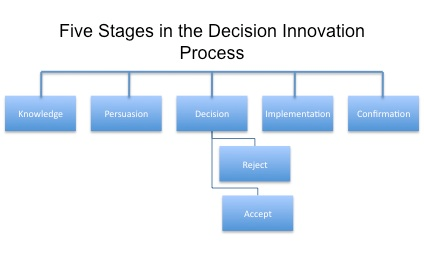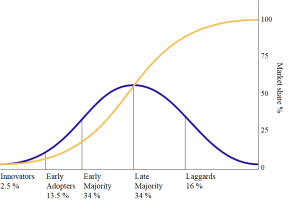The secret may be in organization-wide changes and lots of support
 Many millions of dollars have been wasted over the years by the well-intentioned, but ad hoc, introduction of technology into education. Eager tech savvy teachers or administrators may jump in feet first, but a significant portion of their colleagues are left struggling along or resisting the change.
Many millions of dollars have been wasted over the years by the well-intentioned, but ad hoc, introduction of technology into education. Eager tech savvy teachers or administrators may jump in feet first, but a significant portion of their colleagues are left struggling along or resisting the change.
The results of well-planned, long-term implementations, however, can produce momentum. When even reluctant adopters are given support, training, and time, positive changes can occur.
The diffusion of innovation
Teachers are similar to other groups in society. They follow the “Diffusion of innovation” graph as proposed by Everett Rogers. This categorizes users (teachers) into innovators, early adopters, etc. (users are represented by the blue line; the yellow represents market share, which will eventually reach the saturation level).
Next page: Deconstructing the tech adoption process
However, for organization wide change to occur, the late majority and laggards (I prefer to call them reluctant adopters) must be actively involved in the change. We cannot leave it to the innovators and early adopters.
This takes time and effort, and a fair amount of discussion, understanding, and gentle persuasion.
The five stages of adoption
Researchers have identified five stages of adoption that occur during the process of getting all stakeholders positively engaged in change. These are shown in the diagram below. The five stages are
- Knowledge – The person is made aware of the innovation.
- Persuasion – The person becomes more informed of the change.
- Decision – The person compares the advantages and disadvantages of the change and chooses whether to become involved.
- Implementation – The innovation is used. More information may be sought during this process.
- Confirmation – The decision on whether to continue to use the innovation or abandon it is reached.
 Problems revealed at the implementation stage
Problems revealed at the implementation stage
Getting the late majority and reluctant adopters to the stage where they decide to implement the change may take years. The implementation stage is the point where the school leader may think that the hard work has been done and that implementation will become easier.
Next page: Solutions to the problem
However, this is where some significant insights become obvious, as the late majority and reluctant adopters are often in these categories for other aspects of technology based innovation. That is to say that even when people in the late adopter and reluctant adopter stages do engage in technology-based change, they may find this difficult as they have a limited technology skill set. This was reinforced recently when a teacher I know who had taken a long time to accept the need for change confided the amount of time required to complete some preparation for blended learning; it was many hours. However, it would have taken only an hour or so for someone with a more advanced skill set.
This can then produce a negative feedback loop which hampers implementation. There is always the juggling of effort vs outcomes. The reluctant adopter may reach the point where he or she looks at the amount of effort required to change and decides that it is too much. The teacher then reverts to the old paradigm and methods.
The reluctant adopter not only has to deal with the current change, he/she also has to deal with the task of developing some of the more fundamental technology-based skills that may be required. This may be overwhelming.
School leaders are thus left in an interesting position.
They realize that
- Organization-wide change is vital for long-term success.
- All teachers thus need to be “on board.”
- All teachers are at different levels of understanding and skill development, and need to be brought to a minimum standard so that success can occur in a reasonable time.
- Some staff may have a very limited skill set, and thus need a significant amount of training to be able to work in a blended learning environment with a “normal” amount of effort.
How to solve the problem
This leaves a few possibilities.
- Hope that things will “just work out.” Not a good plan.
- Forget about organization wide change and work only with the innovators, early adopters and early majority. The idea here is that hopefully the rest will decide to follow. I have not seen this work across a whole organization, and I’ve found no research indicating that it happens.
- Provide online training and expect staff to upskill in their own time. This is probably not suitable or sufficient if it is the only solution implemented.
- Build an environment of trust, understanding and support so that teachers feel comfortable asking for help when things are difficult or take too much time. This requires significant effort and allocation of resources. People and training resources must be available when needed. It requires a staffing model where enough support staff, and the right type of support staff, are available when needed.
- Allocate individualized (and possibly confidential) professional development time and resources. Teachers should be supported in their quest to gain skills, and should not feel embarrassed about what they don’t know.
No doubt there are more possibilities, and a blend of some options is probably needed. This is not meant to be a complete list of solutions. It is meant to be a discussion starter.
What is obvious is that traditional structures in schools have to change to support all staff as they move to a new paradigm of teaching and learning.
The future of our students is too important to leave things unchanged.
- TC- What student choice and agency actually looks like - November 15, 2016
- What student choice and agency actually looks like - November 14, 2016
- App of the Week: Science sensor meets your smartphone - November 14, 2016



Comments are closed.